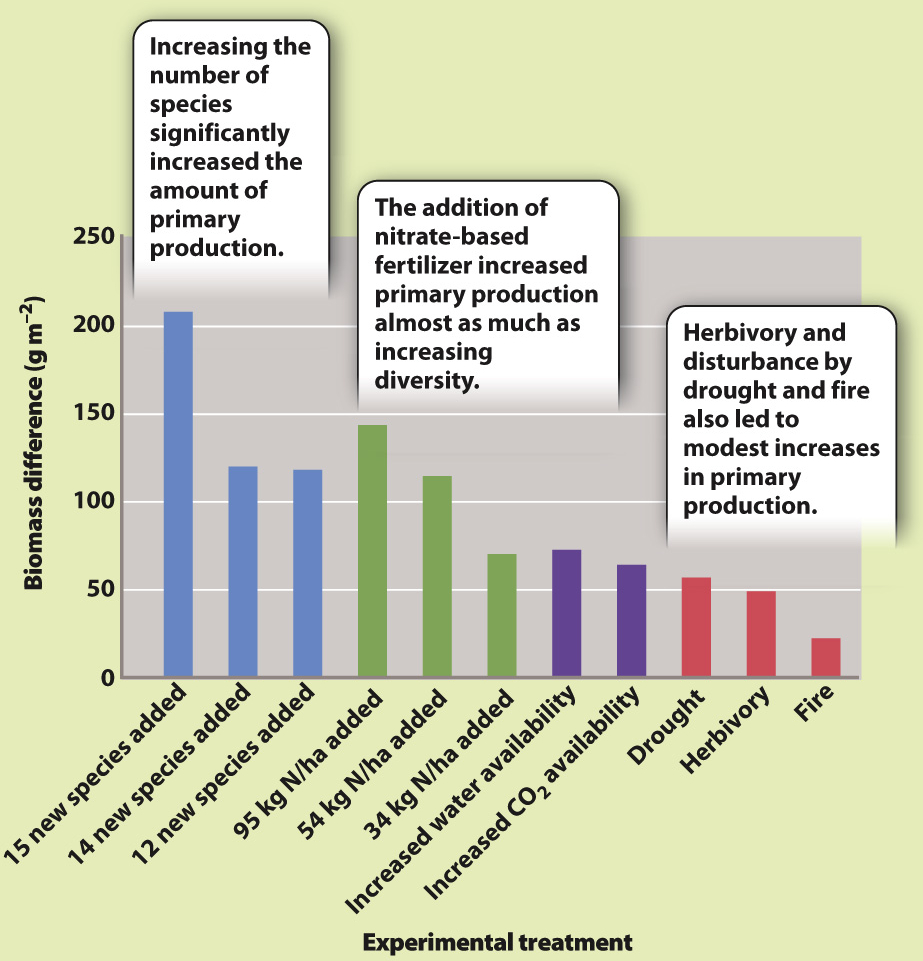Light, water, nutrients, and diversity all influence rates of primary production.
If most ecosystems rest on a base of primary production, what controls rates of photosynthesis? Sunlight plays a role. Although all ecosystems, from polar deserts to equatorial forests, receive the same total number of hours of sunlight annually, as we discuss in Chapter 48, the intensity of solar radiation declines from the equator to the poles because of Earth’s curvature. Seasonality also becomes more pronounced toward the poles, influencing the ability of primary producers to sustain growth throughout the year at higher latitudes.
In addition to sunlight, water and nutrients govern rates of primary production in most ecosystems. In Chapter 29, we saw that plants perform a physiological balancing act, opening their stomata to allow carbon dioxide into leaves but losing water vapor as a result. Because photosynthesis requires both carbon dioxide and water, photosynthetic rate—
Even where water is not limiting, rates of photosynthesis are constrained by the availability of nutrients. This is why fertilizer generally increases crop yields (Chapter 29). Plants, algae, and photosynthetic bacteria all need nitrogen, phosphorus, sulfur, iron, and an array of trace elements to grow, and any one of these can limit primary production. In forests, nitrogen is commonly the soil nutrient that is least abundant relative to the needs of plants. In the open ocean, nitrogen can also be limiting, but usually it is a scarcity of phosphorus that limits photosynthesis. And in some parts of the ocean, nitrogen and phosphorus are both present in abundance, but primary production is still limited—
The biodiversity of a given region reflects its level of primary productivity. We have seen that the population sizes of predators depend on prey population size, which depends on primary production, and greater primary production also means a greater variety of plants of different sizes and kinds that can support a greater variety of herbivorous animals. While this suggests that high productivity can foster high diversity, recent experiments show that the reverse may also be true: Biodiversity may itself play an important role in ecosystem productivity (Fig. 47.18). This is a result of the many different ways that different plants and animals may use the resources presented by soil, water, and sunlight in a particular place. Collectively, a diverse collection of species will be more productive than a single species because no species is adapted for all functions in a given set of conditions.
HOW DO WE KNOW?
FIG. 47.18
Does species diversity promote primary productivity?
BACKGROUND The different plant species found in communities have combinations of leaves, stems, and roots that tap different sources of water and nutrients in the soil and capture light at different levels of sun and shade. Do the differences among plant species result in higher levels of primary production than would be possible with fewer species?
HYPOTHESIS Plant diversity promotes primary production within a community.
EXPERIMENT Ecologist David Tilman conducted a long-
RESULTS The graph shows that the addition of nitrogen fertilizer [quantified as kg of N per hectare (ha)] increased primary production significantly, and additional water, higher CO2, herbivory, and disturbance also resulted in at least a modest increase in productivity. The difference in primary production between high-

CONCLUSION The hypothesis was supported: In the grassland community under study, species diversity promoted primary production.
FOLLOW-
SOURCE Data from Tilman, D., P. B. Reich, and F. Isbell. 2012. “Biodiversity Impacts Ecosystem Productivity as Much as Resources, Disturbance, or Herbivory.” Proceedings of the National Academy of Sciences USA, 109:10394–
The diversity of species on Earth or in a specific place is ultimately the result of the evolutionary, physiological, behavioral, and ecological processes we discussed in the preceding chapters. We follow changes over time in an aquatic and terrestrial habitat to summarize key concepts about population growth, species interactions, communities, and ecosystems in Fig. 47.19. We also introduce ways in which humans affect these processes, a topic that we revisit in Chapter 49.
VISUAL SYNTHESIS
